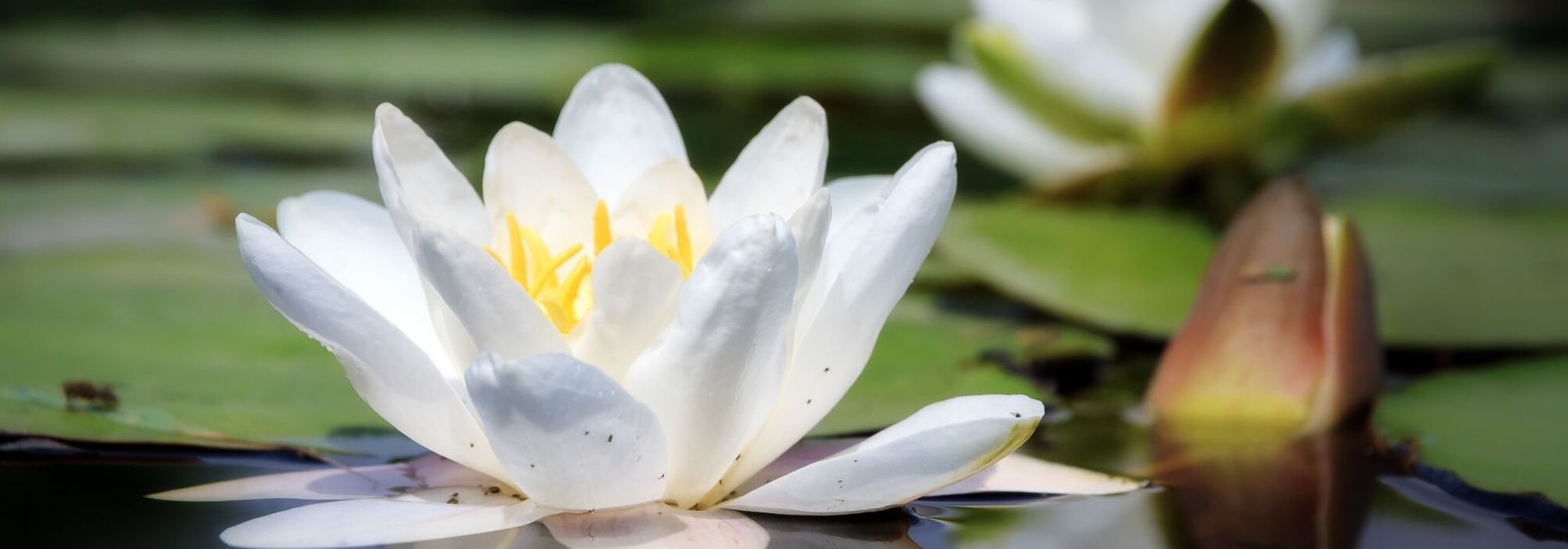
Nymphea, water lily: planting and care
Contents
Water lilies in a nutshell
- Water lilies are floating aquatic plants, spectacular when flowering
- There are many species and even more hybrids, of all sizes and in a variety of colours: white, pink, yellow, red, blue…
- They can be grown in any pond or pool and are very easy to care for.
- Water lilies can sometimes become quite invasive and should be managed from time to time.
- Water lilies also provide shelter and resting and egg-laying surfaces for a range of wildlife.
A word from our expert
If you are a frog, you love water lilies! If you are a dragonfly, you love water lilies! If you love flowers and wet mediums, you love water lilies! In short, it’s hard not to be crazy about these flowers that seem to rise suddenly from water in a range of colours: white, yellow, pink, red and even… blue.
Claude Monet himself fell under the spell of these plants at the 1889 Paris Universal Exhibition, when he barely glanced at the Eiffel Tower before lingering in admiration of the very first Nymphaea hybrids. So much so that he planted many in his Giverny pond and later devoted no fewer than 250 paintings to the subject. A true obsession!
But not all water lilies are the same! Indeed, French groups under this generic name several different genera such as Nuphar and Victoria. Just like the term “lotus”, also particularly overused, which can mean anything. Here, we will speak only of the genus Nymphaea.
Nymphaeas are aquatic perennial plants, hardy or not that can be accommodated in any pond or basin, or even in mini-ponds. They are very easy to maintain provided you manage them to prevent them from taking over.
Description and botany
Botanical data
- Latin name Nymphaea sp.
- Family Nymphaeaceae
- Common name water lily, Nymphea, lotus
- Flowering June to September
- Height 10 to 15 cm
- Sun exposure sun
- Soil type clay-loam
- Hardiness -15°C (for hardy varieties)
The term “water lily“, often covers both Nymphaea and Nuphar, which are botanically close and all belong to family Nymphaeaceae. Here we focus on genus Nymphaea, which comprises some fifty species worldwide and many hybrids. These are perennial aquatic plants whose leaves and flowers float at water surface.
Primarily grown for ornamental interest because of their foliage and flowering, water lilies are also essential to balance of a pond by providing shade and a landing surface for fauna, and by contributing slightly to water oxygenation.
Water lily flowers have the particular habit of opening in light and closing in darkness (a handy way to tell if weather is fine!). In addition, coloured flowers lighten or darken over days. They are hermaphrodite and are fertilised by pollinating insects. This is called entomogamy.
After fertilisation, often three or four days after flowering begins, the pedicel coils and turns back under water where the fruit, an achene, develops. Seeds are released when ripe. They float on surface thanks to an aril filled with air that acts as a buoy, then are dispersed by wind and currents. Later they sink to germinate in mud. Seeds do not resist drought and must remain constantly moist. It seems European pond turtle (Emys orbicularis) can also disperse seeds by passing them through its digestive tract: a fine example of endozoochory.
Water lily can also reproduce asexually by fragmentation of the rootstock. All this makes this plant particularly well adapted to rapid colonisation of aquatic habitats. Take care in garden ponds and small basins!
Leaves float at water surface to capture solar energy. One particularity is that stomata, which allow gas exchanges among other functions, occur only on the exposed face; the submerged face has none. Leaves are produced on long petioles and are cordate (heart-shaped). Upper surface is green and underside more or less purple. Size varies greatly by species and can range from 6 cm diameter to over twenty centimetres. Leaves disappear in winter but new shoots appear the following spring.
Nymphaea alba and Nymphaea candida (Hardy)
They occur in Europe and North Africa. In wild, white water lily (Nymphaea alba) develops in still waters, lakes or backwaters. From the rootstock, sometimes deeper than two metres, grow leaves whose laminae float at surface. Leaves are large, somewhat cordate and leathery, with well-marked lobes. Semi-double corolla comprises about twenty petals with numerous stamens bearing conspicuous yellow anthers. In France a very similar species called northern white water lily (Nymphaea candida) with smaller habit can be found.
Nymphaea ampla (Hardy)
Nymphaea ampla, or white lotus or spotted water lily, grows naturally in Central and South America. It produces elegant star-shaped, fragrant white flowers on a vigorous green stem that holds the flower about ten centimetres above water. Leaves are almost round with dentate margins, green with soft purple edges. Despite original distribution, this nymphaea is very hardy.
Nymphaea caerulea and Nymphaea capensis (Tender)
Nymphaea caerulea, or blue lotus or blue water lily, originates from North Africa, notably Egypt where it was used ritually in Antiquity, and bears large starry flowers with pointed bluish petals. Nymphaea capensis is often confused with N. caerulea but flowers a deeper blue. Both species are not hardy and must be overwintered during cold season.
Nymphaea lotus and Nymphaea odorata (Tender)
Nymphaea lotus, or tiger lotus or Egyptian lotus, occurs naturally from East Africa to Southeast Asia. Submerged leaves are lanceolate and striate with brown markings; floating leaves are round and green. Flowers are starry and white. Both species are not hardy and must be overwintered during cold season. Nymphaea odorata is highly fragrant and has very glossy leaves.

N. alba – N. ampla – N. caerulea – N. lotus
Nymphaea gigantea (Tender)
Native to Australia and New Guinea, this water lily bears very large leaves (60 cm diameter) and large blue flowers (30 cm diameter).
Nymphaea tetragona (Hardy)
Present across much of Northern Hemisphere, this is a miniature water lily with charming cream-yellow flowers about five centimetres in diameter.
Hardy hybrid water lilies
They result from crosses between various European and North American species such as Nymphaea alba, N. mexicana and N. odorata. These very hardy water lilies produce floating flowers in white, pink, red, yellow… up to fifteen centimetres in diameter.
Tropical water lilies flowering by day or night (Tender)
These are hybrids derived from species from tropical forests of Africa, Asia and South America. All produce colourful flowers — red, purple, pink, yellow… — but some flower during daytime (diurnal) while others open in evening and at night (nocturnal). In any case, these hybrids must be overwintered in a room kept at minimum 10°C in winter.

N. gigantea – N. tetragona – N. ‘Attraction’ / Nelumbo nucifera (sacred lotus)
please note: nymphaeas are sometimes called lotus in common language. Be aware that Nelumbo nucifera, called sacred lotus or Oriental lotus, is not a Nymphaea and belongs to another family, Nelumbonaceae.
please note also: yellow water lily (Nuphar lutea), a native species, produces smaller yellow flowers and more elongated, less thick leaves.
Read also
10 aquatic plants, submerged or floatingBest varieties
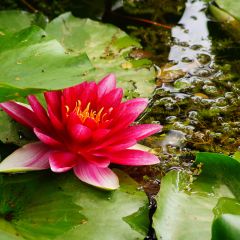
Nymphaea Attraction - Water Lily
- Flowering time July to October
- Height at maturity 20 cm
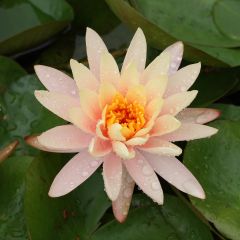
Nymphaea Aurora - Water Lily
- Flowering time July to October
- Height at maturity 15 cm
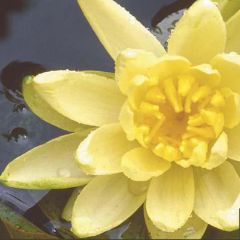
Nymphaea Colonel A.J. Welch - Water Lily
- Flowering time July to October
- Height at maturity 20 cm
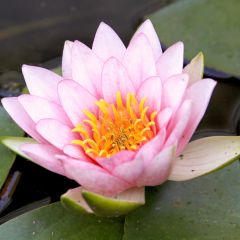
Nymphaea Fabiola - Water Lily
- Flowering time July to November
- Height at maturity 15 cm
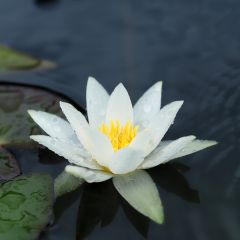
Nymphaea tetragona - Water Lily
- Flowering time July to October
- Height at maturity 10 cm
Discover other Nymphaea - Water Lilies
View all →Available in 0 sizes
Available in 0 sizes
Available in 1 sizes
Available in 1 sizes
Available in 1 sizes
Available in 1 sizes
Available in 1 sizes
Available in 1 sizes
Available in 2 sizes
Planting water lilies
Where to plant?
In water! But in a very sunny spot because water-lilies need at least six hours’ sun to flower well. They take up quite a lot of space, allow 1 m² per plant, and do not like being disturbed: protect them from wind and any spray of water. On a terrace, for example, you can plant a single water-lily in a container at least 1 m wide and 45 cm deep: old washtub, trough, old barrel…
When to plant?
Hardiest water-lilies can be placed in water from mid-March until September. For more tender varieties, wait until June before placing in a pond.
How to plant?
Plant water-lilies in pockets of clay soil prepared on the bottom of the pond or, more easily, in baskets specially designed for aquatic plants. These have the advantage of being easy to position and… to remove if you need to move the plant. They also prevent water-lilies from spreading too much.
- Fill baskets with a good clay soil or with aquatic plant compost (sold in garden centres) that contains a large proportion of clay. Do not use another substrate (general-purpose compost, soil that is too light, etc.) as it will disperse in water and not stay in the basket. Also avoid substrates that are too rich in nitrogen, which will encourage the water-lily to produce too much foliage at the expense of flowering. Instead use long‑lasting fertiliser tablets designed for this purpose.
- Place a single rootstock of water-lily on a diagonal in the basket filled with clay soil. Ensure the terminal bud faces upwards but do not cover it with soil. Take care not to break the roots, which are fairly fragile.
- Immerse the basket in a bucket of water to thoroughly soak the clay substrate. If you intend to put your water-lily in a pond with fish, consider covering the top of the basket with gravel and large stones so fish cannot root around in the soil and muddy the water.
- Place the basket for a few days in a shallow part of the pond. The water-lily will start growing fairly quickly. Once it has, gradually lower the plant into the water to its final position.
→ Learn more in Planting water-lilies and Installing a water-lily in a small pond on a balcony or terrace.

Planting a water-lily in a basket
Care and maintenance
Care
For hardy water lilies :
- In summer, remove some surface leaves if foliage becomes too extensive. Foliage of any plant must not cover more than two-thirds of pond or pool surface or flora and fauna may die. Moreover, excessive shade will encourage algae growth.
- In autumn, remove all yellowed leaves to prevent them rotting and speeding up silting of the water feature.
For less hardy water lilies :
- They need the same care as above but…
- They should be lifted out of water in October and overwintered in a tub of water kept at a minimum temperature of 10°C. Plants can return to pond or pool outdoors during May, possibly June.
All water lilies need feeding as they are fairly hungry plants. Use fertiliser tablets for aquatic plants designed for this purpose and press them into potting soil of pots in spring.
Read also : How to repot a water lily that has become too cramped?
Possible diseases
Black aphids can entirely cover stems and flower stalks above water during warm, humid springs. If very numerous, they can weaken the plant by feeding on its sap. Fortunately, aphids never learned to swim and are hopeless at breath‑holding contests. In that case, dip leaves under water for a few minutes: guaranteed effective.
Insects such as the water‑lily galerucella (Galerucella nymphaeae), a small beetle of the family Chrysomelidae, and the water‑lily moth (Elophila nymphaeata), a moth of the family Crambidae, can attack water‑lily leaves without causing major damage to the plant. These two species are specialised on water‑lilies, so they have every right to be there. If you find them, it will be proof your garden is natural.
Yellow spots on leaves, quickly turning black and even killing leaves, are a warning sign that your water‑lily is not being grown under ideal conditions. To prevent development of fungi and moulds, place your water‑lily in full sun and do not cover terminal bud with soil. Planting too densely can also be problematic, so take into account space each water‑lily requires before planting.
Propagation by division
Sowing is very complicated and should be left to professionals for obtaining new varieties by hybridization.
However, you can easily divide the rootstock when plant starts flowering less, on average every four years. Carry out operation in early spring or at end of flowering.
Take the basket out of the water and rinse with water to reveal the rootstock. Cut pieces of secondary rootstock at least ten centimetres long, taking care that these pieces contain a terminal bud, from which leaves will emerge, and some well-developed roots. Replant this piece of rootstock promptly as indicated in the planting section.
→ Find out more about dividing a water lily in our tutorial
Combining water lilies
In a large pond
A beautiful colony of Nymphea hybrid ‘Attraction’ will be stunning in a large pond stocked with koi carp. The fish will find good shade there during the hottest days of the year while they will reduce impact of black aphids: a kind of mutualism. Obviously in a large pond, choice of plants can be quite wide; you can place a broad selection of floating aquatic plants, submerged aquatic plants or marginal plants. For example, a white Thalia, with Canna-like appearance, will bring a pleasing vertical element to the pond. Or this striking Orontium or candle plant, whose characteristic habit, with flowering in spadices, will contrast beautifully with the water-lilies. A nice clump of variegated Glyceria at the pond edge will contribute to a lush, verdant effect.
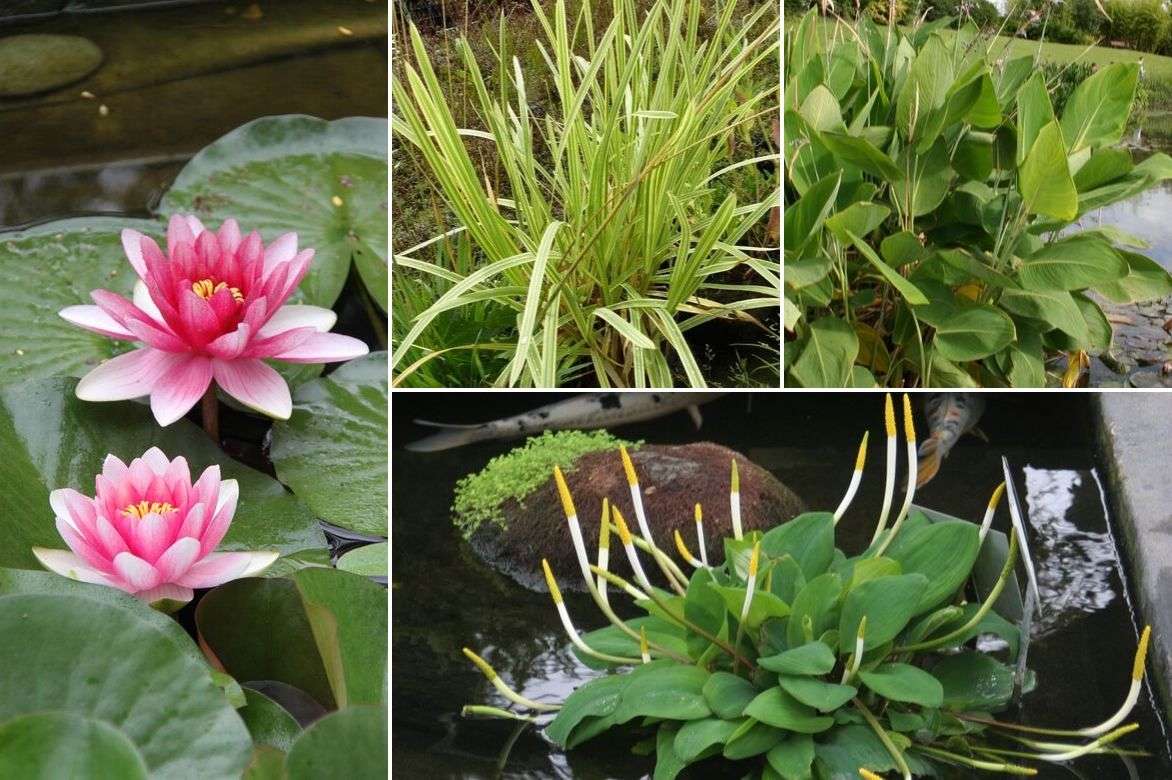
An example of a planting scheme in a large pond: Nymphea hybrid ‘Attraction’, Glyceria maxima ‘Variegata’, Thalia dealbata and Orontium aquaticum
In a natural pond
A natural pond should remain… natural, so favour robust plants and, if possible, species from local flora. Most will, surprisingly, appear by themselves: bulrush, rush, water mint, marsh forget-me-not… Try, nonetheless, this charming little Nymphea ‘Aurora’ with semi-double, starry flowering that changes from cream to yellow, salmon-orange then blood-red as it ages. On the banks, water plantain and flowering rush will brighten pond margins. A fine clump of marsh iris will enliven pond edges from April to June, as will a few plants of meadowsweet a little further back, another native that likes very wet ground. A handsome Lythrum salicaria ‘Robert’ will complete the picture.
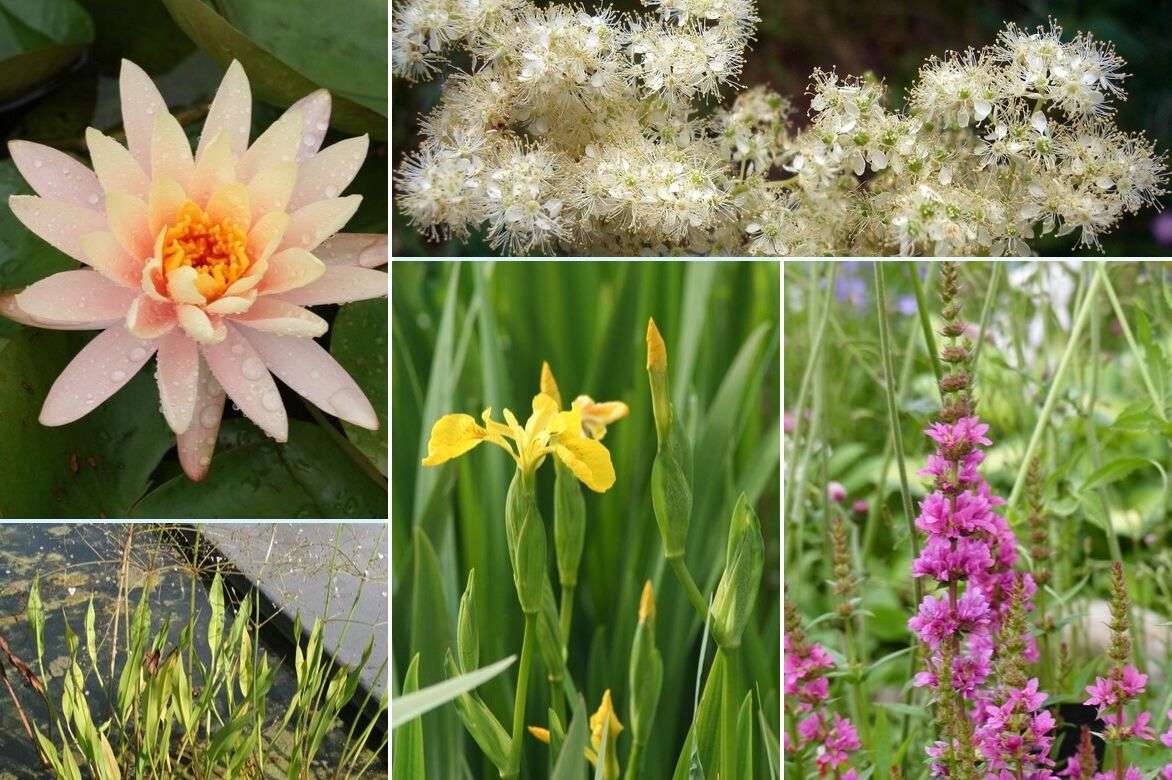
An example of a planting scheme in a natural pond: Nymphea ‘Aurora’, Filipendula ulmaria, Alisma plantago, Iris pseudacorus and Lythrum salicaria ‘Robert’
In a mini aquatic garden on the terrace
You can easily create a mini aquatic garden in an old trough, a vintage zinc washtub or any watertight container at least fifty centimetres deep and one metre in diameter. In this case favour quality over quantity by choosing only aquatic plants of modest size but high aesthetic impact. For example this miniature water-lily, Nymphaea tetragona, ideal for small volumes. Add a small clump of mare’s-tail, Hippuris vulgaris, which will oxygenate and help purify water (beware, however, as it can become somewhat invasive and will need occasional management by removing shoots). To add a little verticality, try a flowering rush, Butomus umbellatus, a charming shallow-water perennial that can be cultivated in a pot.
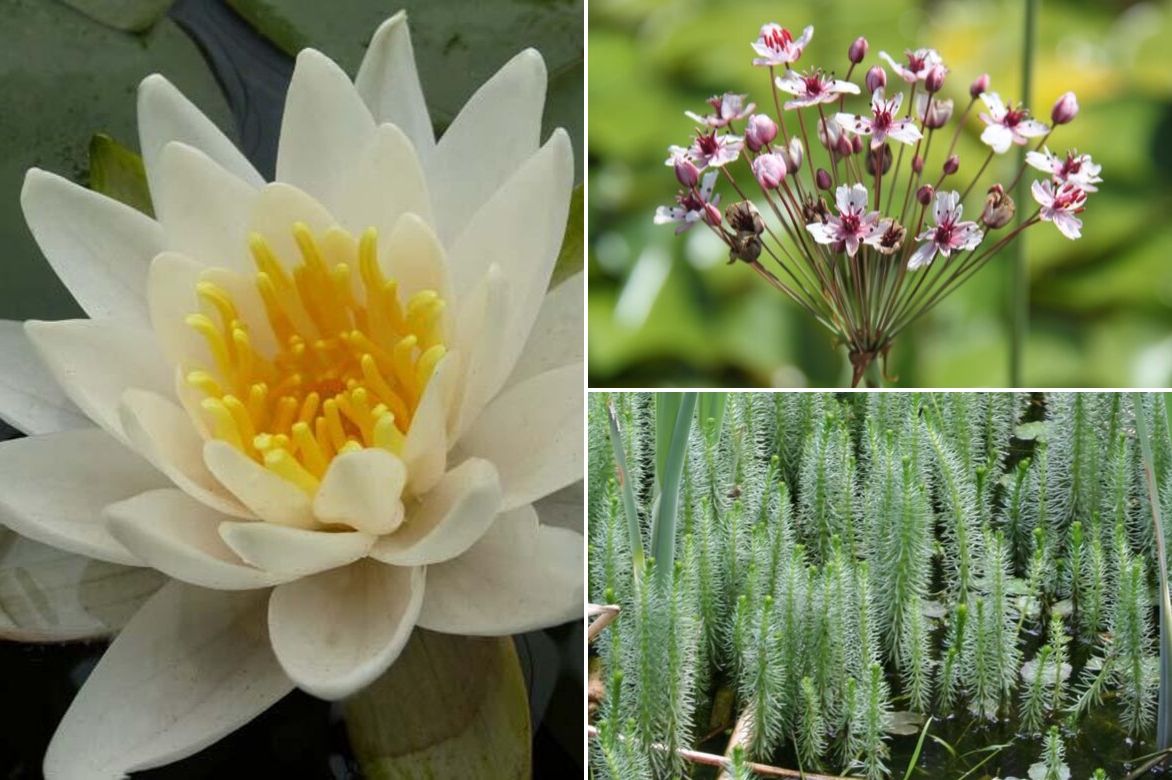
An example of a container planting: Nymphaea tetragona, Butomus umbellatus and Hippuris vulgaris
Did you know?
- Water lilies are indicator species of water quality in a medium.
- Some Native Americans, notably those of the Ojibwe tribe, consumed flower buds of Nymphaea
- Nymphea caerulea and Nymphea lotus were sacred in ancient Egypt. They symbolised god Ra (sun) because of flowers opening by day and closing at night.
- In 1889, at the Paris Universal Exposition (the one that left us the Eiffel Tower…), the first water-lily hybridiser, Joseph Bory Latour-Marliac, showcased his production. Claude Monet, passing by, fell in love with them. So much so that they still flower in ponds of the gardens at Giverny and Monet’s most famous series, of no fewer than 250 paintings, is called… Water Lilies.
- Latour-Marliac’s nursery still exists and still offers a wide variety of water lilies.
Useful resources
- Discover our full range of Nymphaea water lilies in our online nursery.
- Our care guides:
- Installing a water lily in a small pond on a balcony or terrace
- Our selection of water lilies and dwarf lotuses for mini-ponds.
- Non-hardy water lilies: how to protect them from cold and overwinter them?
- How to clean a pond overrun by water lilies?
Frequently asked questions
-
A sort of gelatine covers the underside of the leaves of my water lilies. Is it serious?
Congratulations! You are a proud parent of a brood of pond snails (Lymnaea), an aquatic mollusc. Don't worry, they will cause no harm to your plants as they feed mainly on algae and duckweed.
- Subscribe!
- Contents
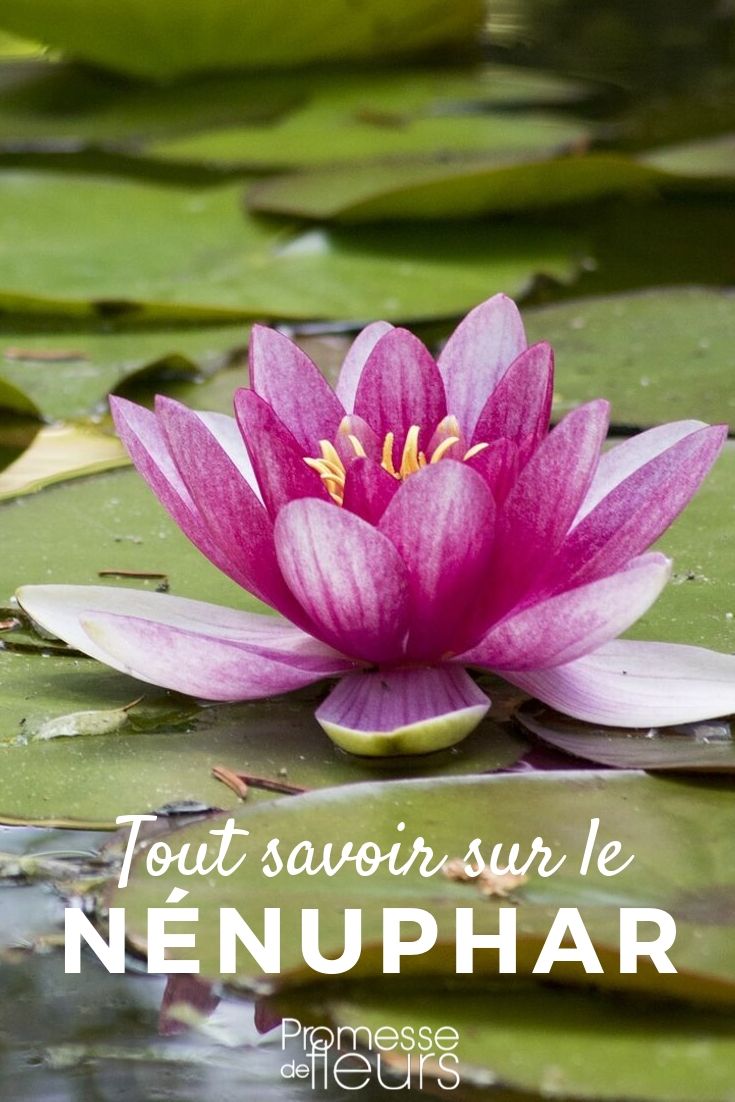































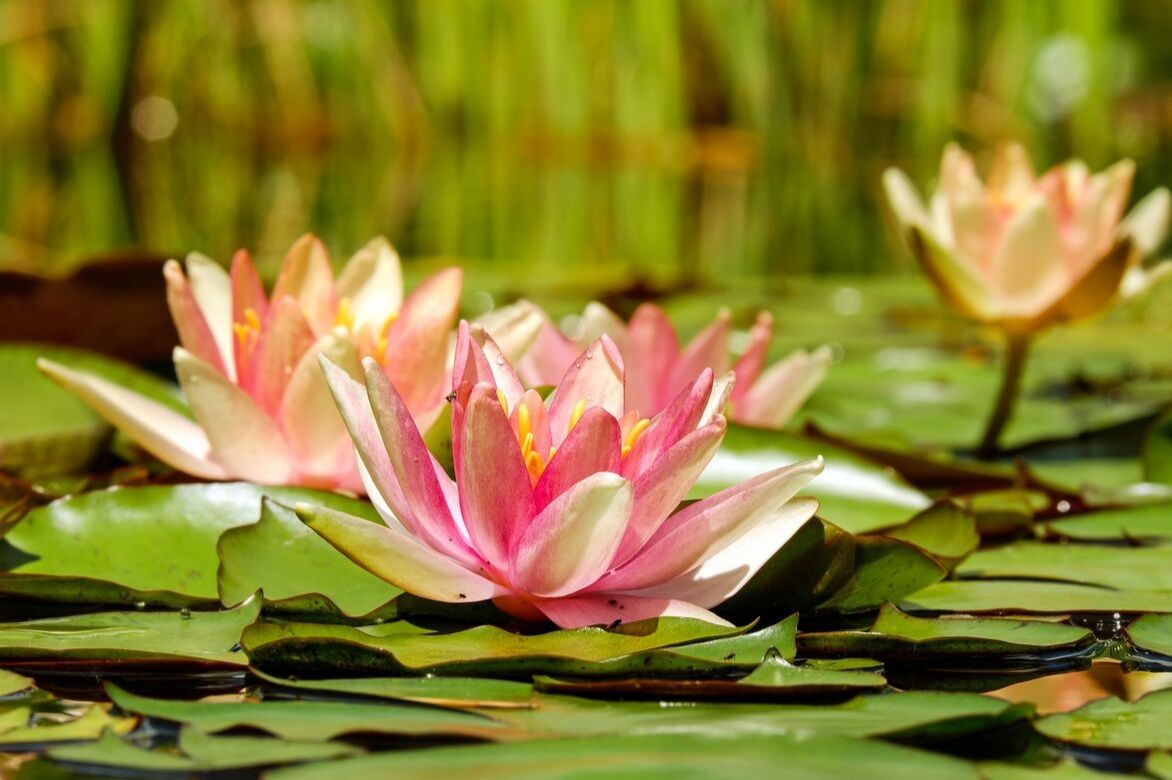
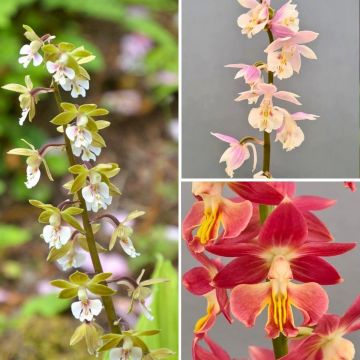
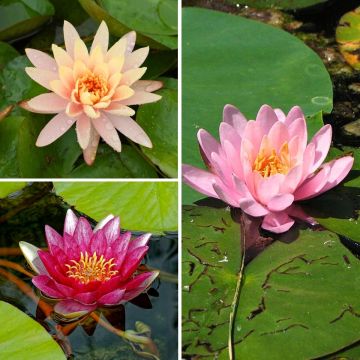
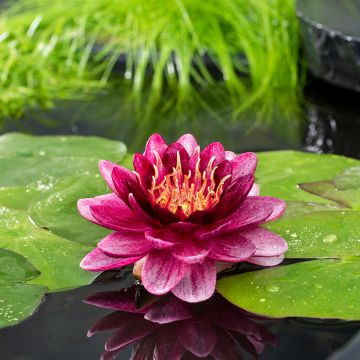
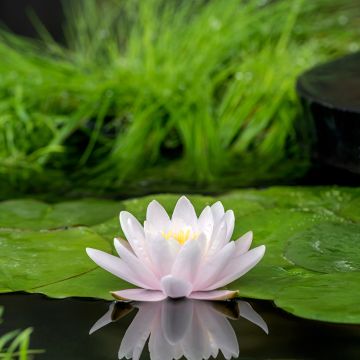
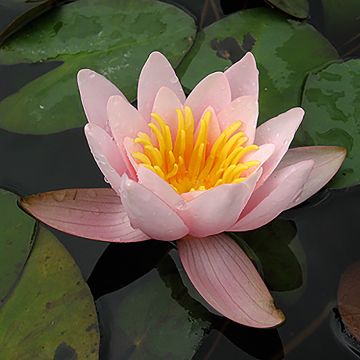
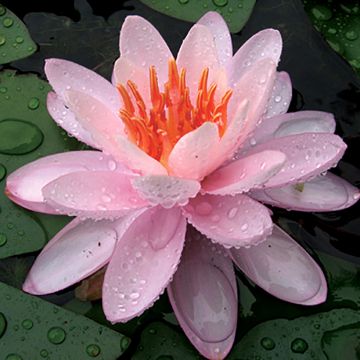
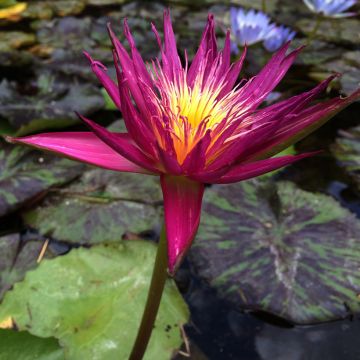
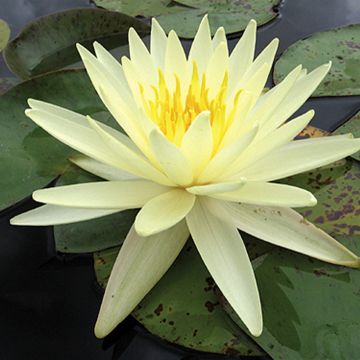


Comments